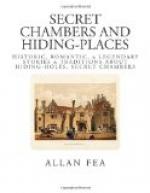At Tyttenhanger House, Hertfordshire, and in the old manor house of Newport, Isle of Wight (where the captive King Charles I. spent some of his last melancholy days), there are rooms with passages in the walls running completely round them. Similar passages were found some years ago while making alterations to Highclere Castle Hampshire.
The once magnificent Madeley Court, Salop[1] (now, alas! in the last stage of desolation and decay, surrounded by coal-fields and undermined by pits), is honeycombed with places for concealment and escape. A ruinous apartment at the top of the house, known as “the chapel” (only a few years ago wainscoted to the ceiling and divided by fine old oak screen), contained a secret chamber behind one of the panels. This could be fastened on the inside by a strong bolt. The walls of the mansion are of immense thickness, and the recesses and nooks noticeable everywhere were evidently at one time places of concealment; one long triangular recess extends between two ruinous chambers (mere skeletons of past grandeur), and was no doubt for the purpose of reaching the basement from the first floor other than by the staircases. In the upper part of the house a dismal pit or well extends to the ground level, where it slants off in an oblique direction below the building, and terminates in a large pool or lake, after the fashion of that already described at Baddesley Clinton, in Warwickshire.
[Footnote 1: This house must not be confused with “the Upper House,” connected with Charles II.’s wanderings.]
Everything points to the former magnificence of this mansion; the elaborate gate-house, the handsome stone porch, and even the colossal sundial, which last, for quaint design, can hold its own with those of the greatest baronial castles in Scotland. The arms of the Brooke family are to be seen emblazoned on the walls, a member of whom, Sir Basil, was he who christened the hunting-lodge of the Giffards “Boscobel,” from the Italian words “bos co bello,” on account of its woody situation. It is long since the Brookes migrated from Madeley—now close upon two centuries.
The deadly looking pits occasionally seen in ancient buildings are dangerous, to say the least of it. They may be likened to the shaft of our modern lift, with the car at the bottom and nothing above to prevent one from taking a step into eternity!
A friend at Twickenham sends us a curious account of a recent exploration of what was once the manor house, “Arragon Towers.” We cannot do better than quote his words, written in answer to a request for particulars. “I did not,” he says, “make sufficient examination of the hiding-place in the old manor house of Twickenham to give a detailed description of it, and I have no one here whom I could get to accompany me in exploring it now. It is not a thing to do by one’s self, as one might make a false step, and have no one to assist in retrieving it. The entrance is




